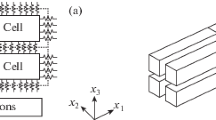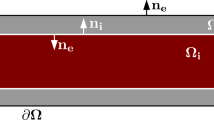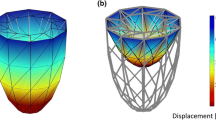Abstract
A model of changes in the intracellular conductivity of the myocardium due to its deformation was developed. Macroconductivities were derived using the microstructure-based model proposed by Hand et al. (2009), where the heart tissue was considered as a periodic grid, the cells were rectangular prisms filled with conducting fluid, and the conductivity of gap-junctions was represented through boundary conditions on the sides of these prisms. In deriving the dependence of conductivities on deformation, some generalizations associated with the layered fiber structure for the tissue and nature of deformation were used. Furthermore, it was assumed that the cytoplasm is an isotropic electrolyte with deformation-independent conductivity, conductivities of gap junctions are constant, and cell deformation is the same as the tissue macrodeformation. Using the homogenization method, conductivity values were expressed analytically through the cell size, parameters of the grid periodicity, and electrical properties of the myoplasm and gap junctions. On the basis of these data, the dependence of the conductivity on tissue deformation was shown. First, we considered a simple model where the deformation is a tension–compression along the axes of the material. A model for a general case of deformation was then developed. Finally, this model was generalized in order to take the microstructural anisotropy of the myoplasm into account. Our model was compared with the model proposed by F.V. Sachse. It was shown that both models can be well aligned for elongations in the range from 0.8 to 1.2.
Similar content being viewed by others
References
F. B. Sachse, Computational Cardiology. Modelling of Anatomy, Electrophysiology and Mechanics (Springer, Berlin, 2004).
J. Sundnes, G. T. Lines, X. Cai, et al., Computing the Electrical Activity in the Heart (Springer, Berlin, 2006).
I. J. Le Grice, A. Pope, and B. H. Smaill, in Interstitial Fibrosis In Heart Failure (Springer, 2005), pp. 3–21.
I. J. Le Grice, P. J. Hunter, and B. H. Smaill, Am. J. Physiol. 272, H2466 (1997).
M. Zabel, B. S. Koller, F. Sachs, and M. R. Franz, Cardiovasc. Res. 32, 120 (1996).
V. Gurev, M. M. Maleckar, and N. A. Trayanova, Ann. N. Y. Acad. Sci. 1080, 320 (2006).
M. P. Nash and A. V. Panfilov, Prog. Biophys. Mol. Biol. 85 (2–3), 501 (2004).
A. Panfilov, R. Keldermann, and M. Nash, Proc. Natl. Acad. Sci. U. S. A. 104, 7922 (2007).
R. H. Keldermann, M. P. Nash, and A. V. Panfilov, Physica D: Nonlinear Phenomena 238 (11–12), 1000 (2009).
H. Dala, S. Göktepe, M. Kaliske, and E. Kuhl, Comput. Methods Appl. Mech. Eng. 253, 323 (2013).
S. Göktepe and E. Kuhl, Comput. Mech. 45, 227 (2010).
H. Xia, K. Wong, and X. Zhao, Comput. Math. Methods Med. 2012, Article ID 927279 (2012).
J. P. Keener and A. V. Panfilov, Biophys. J. 71, 1335 (1996).
J. Keener and J. Sneyd, Mathematical Physiology (Springer, 2009).
W. Krassowska and J. C. Neu, IEEE Trans. Biomed. Eng. 41 (2), 143 (1994).
J. Stinstra, B. Hopenfeld, and R. Macleod, Ann. Biomed. Eng. 33, 1743 (2005).
G. Richardson and S. J. Chapman, SIAM J. Appl. Math. 71(3), 657 (2011).
P. E. Hand, B. E. Griffith, and C. S. Peskin, Bull. Math. Biol. 71 (7), 1707 (2009).
A. Gizzi, C. Cherubini, S. Filippi, and A. Pandolfi, Comm. Comput. Phys. 17 (1), 93 (2015).
Author information
Authors and Affiliations
Corresponding author
Additional information
Original Russian Text © I.N. Vasserman, V.P. Matveenko, I.N. Shardakov, A.P. Shestakov, 2018, published in Biofizika, 2018, Vol. 63, No. 3, pp. 589–597.
Rights and permissions
About this article
Cite this article
Vasserman, I.N., Matveenko, V.P., Shardakov, I.N. et al. Derivation of the Macroscopic Intracellular Conductivity of Deformed Myocardium on the Basis of Microstructure Analysis. BIOPHYSICS 63, 455–462 (2018). https://doi.org/10.1134/S0006350918030247
Received:
Published:
Issue Date:
DOI: https://doi.org/10.1134/S0006350918030247




